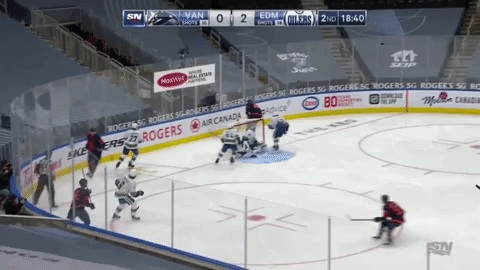Breaking Down Connor McDavid's Revealing Back-to-Back
#97's performance against Vancouver showed why he's a generational offensive threat and revealed a path to defensive redemption.
Connor McDavid grabbed the hockey world’s attention on Thursday night with a dominant hat-trick performance against the Vancouver Canucks. He was flying all over the ice, working his ass off, and had the Canucks on their heels the entire time. And the Oilers needed it: they came out flat on opening night as the Horvat-Hoglander pair surprisingly outduelled their first line. It’s far too early in the season to have access to advanced metrics like WAR and RAPM, but by any measure McDavid was far, far more dangerous in the second game of the season. His share of on-ice shots went from 47% to 72%; his game score went from -0.1 to 5.3; he, uh, got a bunch more points.
While adjusted and isolated metrics aren’t available, I’d like to dip into some tape from these games because I think they illustrate a lot of what I’ve previously written and said about McDavid’s analytics, where they come from, and how they might even improve. I think it’s a safe bet that if he stays healthy, #97 will compete for and probably win the Art Ross trophy this year. But what about his infamously awful defensive numbers? In my mind, the back-to-back went a long way towards showing not only where those results come from but how they could be improved.
This article would not be possible without the scouting platform InStat Hockey.
Unparalleled Offensive Brilliance
Connor McDavid is a generational offensive player, but he hit another level against the Canucks on Thursday. I clipped together some highlights from just the first period - most players will never make this level of impact in a full game:
The most exciting thing about McDavid in that game to me was that he didn’t use his speed as a crutch. Sometimes when you watch him play, especially when he’s frustrated, he has a one-track mind offensively where beating defencemen to the outside and cutting to the net is his sole priority. But he’s much more dangerous when he does what he did in game #2, working incredibly hard to maintain possession and using every tool at his disposal. Here’s two plays I especially loved:
Three times in the first period he stripped a Canucks player of the puck while they tried to break out, and in each case it led directly to a shot or scoring chances for the Oilers. These types of play also pay off defensively, because every extra second Edmonton spends in the offensive zone is a second that Vancouver doesn’t.
There isn’t much sense in dwelling too extensively on McDavid’s offence, since it’s pretty common knowledge that he’s good at it to say the least. I just wanted to highlight the factors that made him extra unstoppable on Thursday, and could - if sustained - dramatically improve his overall numbers and lead to him not only leading the league once again in aggregate impact stats like WAR and RAPM but blowing away the competition.
Explaining the Defensive Issues
Almost as staggering as McDavid’s offensive brilliance is the amount that he gives back defensively, which I’ve broken down in detail in the past. People are often struck that his results in the past three seasons are so night and day:
The origin of McDavid’s miserable defensive numbers was also quite evident in this back-to-back, even if it was understandably (and fittingly) heavily outweighed by his spectacular offensive performance. With that in mind I thought it would be useful to use these games as a bit of a case study.
Only teams and private companies have access to data on whether chances come from the cycle, off the rush, off odd-man breaks or breakaways, etc. But there are some indicators I like to look for that can give us some signs. The biggest one is the difference between the quantity and quality of chances a player gives up when on the ice. If a player surrenders more quality than quantity, that suggests to me that they are relatively effective at maintaining possession of the puck but what they do allow is really dangerous. I discussed this when I wrote about Erik Karlsson, whose poor defence during his prime was concealed by Corsi but revealed by Expected Goals and Goals Against.
The way I checked this was to see the difference between his percentile rank among forwards in two RAPM isolated stats: unblocked shot attempts against (quantity) and expected goals against (quality). Sure enough, while he’s no prizewinner in terms of quantity, he gives up much worse quality:
The eye test verifies this hypothesis pretty clearly. I clipped the dangerous chances the Oilers gave up when he was on the ice in the first two games, and sure enough they mostly came on counterattacks:
The eternal question with McDavid’s defensive issues is “are they actually his fault?” Look at almost any Edmonton media analysis of his two-way game and you’ll find a goal-by-goal explanation of why it was always the defencemens’ fault and not his that so-and-so goal happened. The plays above are no exception - the chances above can be attributed to multiple Oilers and there isn’t one that you would definitely say is specifically the fault of #97. But when you’re trying to figure out how a forward affects defensive outcomes at a macro level, you’re not usually going to see a pile of goals that are explicitly “their fault.” Sure you can point to turnovers or blown coverage but more often than not, blueliners or goalies are the ones who will look bad on a goal against. And what this analysis doesn’t explain is why these screw-ups happen disproportionately and consistently when McDavid is on the ice. I have two theories.
The first is that in many respects, McDavid plays like a winger. He blows the zone early, winds up very deep in the offensive zone, and as a result it’s typically Kassian or Nugent-Hopkins who’s the first forward back. He does this because he’s the fastest player in the history of the sport and can beat defencemen off the rush consistently. So he is not typically present on the backcheck and rarely uses that speed for defensive purposes. Like on this play, where he’s the deepest forward in the zone by ten feet and gets back to his zone at the same time as a linemate who literally fell over:
The second is that McDavid chooses the tempo of play when he’s on the ice because that’s how dominant he is. Unsurprisingly, that tempo is usually “balls to the wall” (pardon my Italian). This is not an easy speed to play at if you’re a defenceman and leaves you extra prone to making mistakes on the counter-attack. So while on many plays you can pick out mistakes that players like Adam Larsson or Tyson Barrie make, they’re put in the position to screw up by McDavid. This is why these screw-ups objectively happen way more when he’s on the ice.
So what happened in game two? The tempo wasn’t as high, and McDavid rarely had to get back. Why? Because the Oilers possessed the puck for the vast majority of his time on ice - 80% Corsi might even be low-balling it. The best defence in hockey is not a good offence, as analysts like Micah McCurdy (and, well, players like Connor McDavid) have shown. But the best defence is offensive puck possession, and that’s what did the trick on Thursday.
Conclusion
So where do you go from there? McDavid’s defensive numbers were significantly better in the second game, in large part because he and the Oilers did not let the Canucks get the puck. This connects to Jack Han’s conclusion from the bonus chapter of Hockey Tactics 2020:
The real problem for McDavid [defensively] is his offense. If he were better at playing underneath in transition and controlling the middle of the ice, he wouldn’t need to defend nearly as much.
I would extend that a bit further: McDavid is at his best - offensively and defensively - when he generates offence through sustained possession. As we saw above, he is so talented in the offensive zone working on the cycle that when he fully commits to playing that way he is absolutely unstoppable.
This is to say that the key to Connor McDavid dominating the league analytically as well as on the scoreboard is not for him to focus fully on defence or sacrifice offence or anything like that. Yes, it wouldn’t hurt for him to be more attentive on the backcheck, but defensive numbers are so often directly a function of you what you do when your team does have the puck. If he plays most of the season the way he did in game one, his underlying numbers will probably look the same as they did in the past three seasons - excellent offensively, hideous defensively, and overall elite. But if he can build on what he did in game two, we could see something totally next level. That’s what I’m rooting for.






